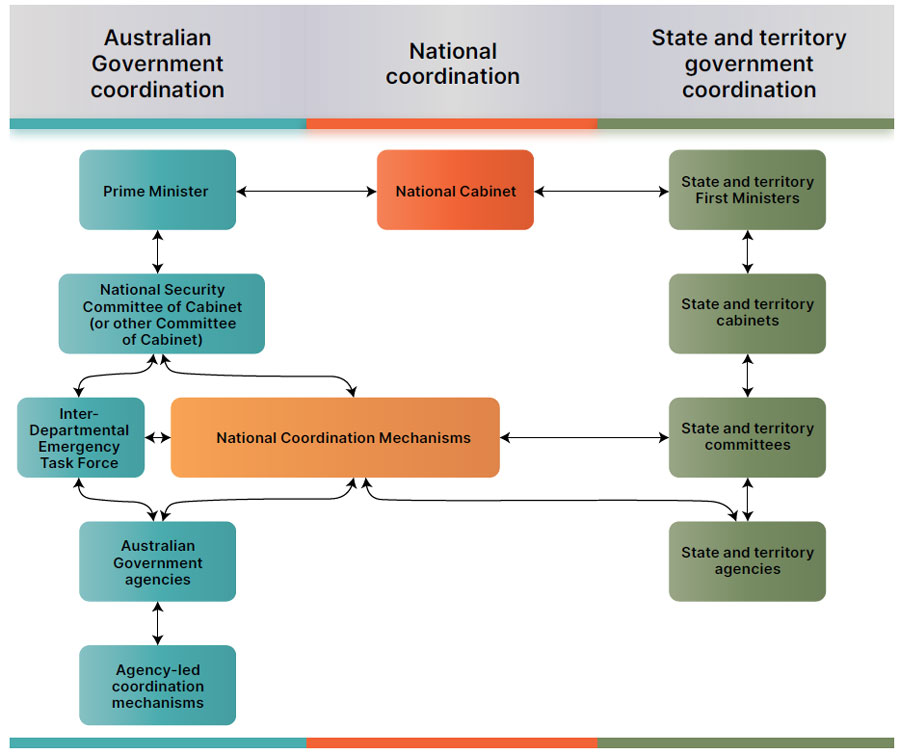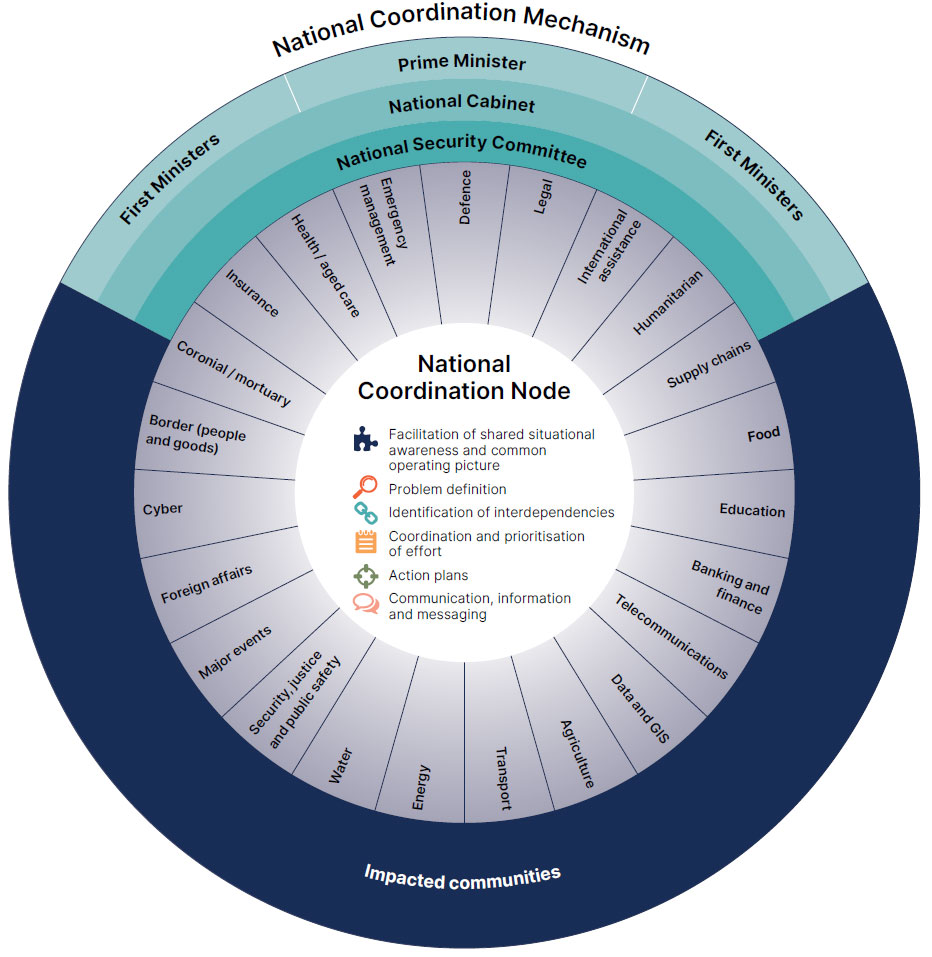Australian Government ministers and officials use various mechanisms to conduct crisis coordination, depending on the nature of the crisis. These mechanisms can rapidly bring relevant stakeholders together to ensure that the crisis response is aligned within the Australian Government as well as between governments and industry, and based on expert advice.
These mechanisms are established as needed, in line with coordination requirements. Australian Government ministerial decisions may be supported through the NSC, the National Cabinet, or other ministerial forums deemed appropriate by the Prime Minister to address the requirements of the crisis.

Figure 9. Mechanisms to support decision-making during crisis coordination
The National Security Committee of Cabinet
The NSC is the peak all-hazards crisis decision-making committee of Cabinet. During crises, the Australian Government can make time-critical ministerial decisions and coordinate responses through short-notice meetings of the NSC. Where NSC crisis considerations have implications for the portfolios of non-NSC ministers, the Prime Minister may agree to co-opt these ministers to the meeting. Where deemed appropriate by the Prime Minister, the chair(s) of the relevant peak senior officials' crisis forum (NCM or IDETF) may be co-opted to the NSC to:
- provide coordinated cross-government updates
- provide advice on resource prioritisation
- provide advice on communications to the public
- inform crisis-related decision-making.
PM&C will provide advice to the Prime Minister as required on co-option of non-NSC ministers, and chair(s) of the peak senior officials' crisis forum to the NSC.
The Prime Minister may also convene other Cabinet Committees to support crisis decision making as the Prime Minister deems appropriate.
National Coordination Mechanism
The NCM is the peak senior officials' crisis coordination mechanism providing a national picture of crisis to governments and key stakeholders. The NCM provides the convening mechanism to bring together Australian Government, state and territory government and non government representatives immediately before, during and after a crisis.
The NCM is flexible, scalable and vector-agnostic. It facilitates rapid problem definition and shared situational awareness, and ensures ownership of solutions to drive the rapid stabilisation of crisis events. It uses a domain- or sector-based approach to promote collaboration between stakeholders with equities in the crisis, strengthening and formalising the existing relationships between governments, industry and civil society. During concurrent, compounding or complex crises, the NCM enables the harnessing of the collective national capabilities to support communities.
During crisis, the strategic aims of the NCM are to:
- facilitate whole of Australian Government and national coordination and decision-making
- maintain near real time situational awareness
- ensure national leadership and the maintenance of public trust in government systems
- ensure that the problem is clearly defined and understood
- agree on lines of effort to mitigate the impacts and consequences of a significant crisis
- ensure actions are synchronised, coordinated and responsive
- support the continuity of critical community functions
- communicate actions and coordinate public messaging
- reduce harm and the overall severity of the crisis.
The relevant DCG NEMA (or delegate) convenes and chairs the NCM on behalf of the Australian Government, supported by NEMA. PM&C may elect to co-chair an NCM. Other relevant Australian Government agencies may co-chair, at the request of the NEMA chair or where they are the Australian Government Coordinating Agency. States, territories, private sector or the not-for-profit sector may request that an NCM is activated for a specific purpose/issue, noting that a decision to activate an NCM remains a matter for the relevant DCG NEMA (or delegate).
NCM participation is flexible and can be wide-ranging. In the context of their role in the NCM, participants bring information, expertise and experience from their sectors, and actively contribute to shared situational awareness and cross-sectoral coordination of priorities and actions.
The NCM (including NCM-AUSGOV – see p. 35) has a formalised reporting line to the NSC, or other relevant Committee of Cabinet as determined by the Prime Minister, during times of crisis to ensure consistent whole of Australian Government situational awareness and response recommendations. Where agreed by the Prime Minister, the chair(s) of the NCM may be co-opted to the NSC to provide briefings on matters related to crisis.
Where appropriate, the chair(s) of the NCM may also brief the Prime Minister and relevant ministers at the earliest opportunity, following a significant crisis.
For Tier 1 to 3 international crisis coordination, the IDETF is the peak senior officials' coordination mechanism. In the case where both the NCM and the IDETF are activated, it is the responsibility of the respective chairs, in consultation with PM&C, to agree which forum will function as the peak senior officials' mechanism.
For Tier 4 crisis coordination, the NCM is the peak crisis coordination mechanism, with IDETF reporting to the NCM.

Australian Government NCM
The Australian Government NCM (NCM-AUSGOV) is a specialised NCM that supports a shared whole of Australian Government picture of crisis, with participants drawn from across the Australian Government.
During crisis, the initial convening of the NCM-AUSGOV should include broad representation across Australian Government agencies where appropriate, to build a comprehensive understanding of all Australian Government equities and interests. Participants should include response and recovery representation from all relevant agencies. This is to ensure appropriate representation during the crisis response phase, where there is a potential role for the Australian Government in supporting recovery activities.
Each participating agency will bring information, expertise and experience from their agency and sector, and actively contribute to shared situational awareness and cross-government coordination of priorities and actions.
The relevant DCG NEMA (or delegate) is chair and NEMA provides secretariat services in collaboration with the Australian Government Coordinating Agency, as required. The relevant Deputy Secretary PM&C (or delegate) may elect to chair or co-chair the NCM-AUSGOV or delegate this responsibility to the Australian Government Coordinating Agency.
When the focus is on response to a domestic terrorism-related event, the Commonwealth Counter-Terrorism Coordinator (or delegate) may chair the NCM-AUSGOV, supported by the Counter-Terrorism Coordination Centre (CTCC) and NEMA. The Deputy Secretary PM&C (or delegate) may elect to chair or co-chair the NCM-AUSGOV.
Capabilities that support the NCM
The NCM is supported with strategic planning, near real time situational awareness and other coordination and decision-support functions by:
- the NSR
- the NJCOP
- the CCT
- the CASP methodology.
The CCT supports coordination of Australian Government operational activities in line with the strategic intent set by the NCM, including the NCM-AUSGOV.
Inter-Departmental Emergency Task Force
The IDETF is the peak senior officials' crisis coordination mechanism during Australian Government responses to international crises between Tiers 1 to 3. The relevant Deputy Secretary DFAT (or delegate) is the chair, and the relevant Deputy Secretary PM&C (or delegate) may co-chair with DFAT where appropriate. DFAT provides secretariat services for the IDETF.
Where agreed by the Prime Minister, the chair(s) of the IDETF may be co-opted to the NSC to brief on matters related to crises. They should seek to brief the Prime Minister and relevant ministers through PM&C at the earliest opportunity, where appropriate.
In response to a crisis that has significant international and domestic consequences, and triggers coordination in line with Tier 4 arrangements, the NCM becomes the peak senior officials' crisis coordination forum (see the Coordination for extreme and catastrophic crises (Tier 4) section on p. 38). In such instances, DFAT remains responsible for delivering response requirements for all international elements of the crisis, and may convene the IDETF to support this responsibility. The IDETF, if convened, reports to the NCM, with the IDETF chair(s) updating the NCM on the international elements of the Australian Government response.
The IDETF chair(s) should also brief DCG EMR NEMA on any offers of, or requests for, assistance from overseas countries.
Portfolio-based mechanisms
Portfolios that maintain national plans and crisis management arrangements may have bespoke coordination and advice-seeking mechanisms within their own portfolios.
Special and temporary mechanisms
When existing crisis arrangements are not fit-for-purpose for a specific crisis, it may be appropriate for the Lead Minister to establish special and temporary mechanisms in parallel with existing mechanisms to ensure effective and aligned Australian Government coordination.
These special and temporary mechanisms may include:
- an inter-departmental committee
- an ad hoc secretaries' coordination meeting
- a dedicated whole of Australian Government taskforce
- government-industry working groups
- the appointment of a special envoy.
Any special purpose or temporary mechanisms should be guided by and complement existing arrangements, to ensure a consistent and effective approach to crisis across the Australian Government. Where special purpose/temporary mechanisms are established, senior officials should ensure arrangements are in place to brief their agencies.
The relevant peak senior officials' crisis coordination mechanism chair (or delegate) should quickly establish the relationship between the peak and new mechanisms, and communicate arrangements to relevant agencies/officials. Specifically, the chair (or delegate) should establish:
- a clear understanding of respective roles, responsibilities and functions
- clear lines for information sharing, decision making and accountability
- a consistent whole of Australian Government communication strategy.
Strategic crisis policy coordination
In significant emerging or protracted crises, there may be the need to establish a whole of government strategic policy coordination mechanism to consider complex strategic policy issues arising from the crisis. The need to establish this mechanism may be driven by:
- a sudden shift in the crisis threat environment that generates the potential for significant acute consequences on Australia or Australian interests
- a severe or protracted crisis prompting the need to shift policy settings to ensure the continuation of societal functions, or enable unprecedented support.
This mechanism would work in parallel with the operational coordination undertaken by the NCM.
The mechanism may support consideration of existing policy settings to prevent the reoccurrence of unintended consequences during crises, and policy issues associated with the transition to longer-term recovery from crises. It may also be used to address identified strategic policy or capability gaps, by coordinating rapid policy development, reforms and proposals. It could be applied during the near-term preparedness, response, relief and early recovery phases of the Continuum (p. 10).
The mechanism would be aligned with the existing special and temporary purpose mechanism provisions under this Framework and be integrated with existing operational crisis coordination mechanisms, particularly the NCM(s). To support this, the chair of the strategic policy coordination mechanism should participate in relevant NCM(s). The mechanism would be established and led by PM&C.
